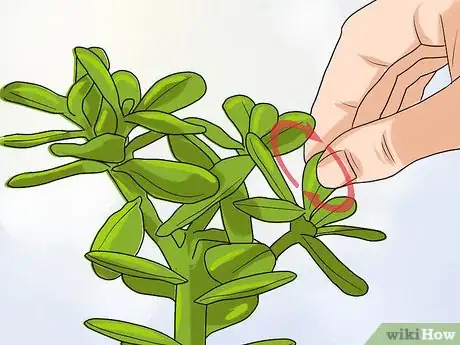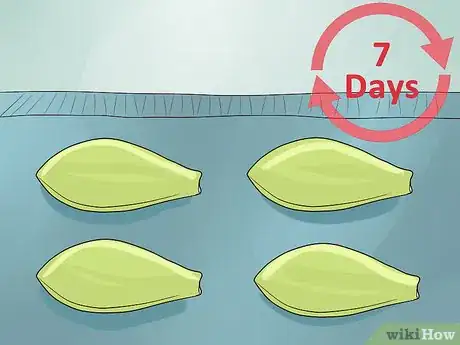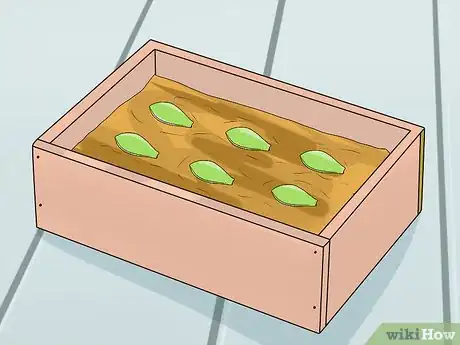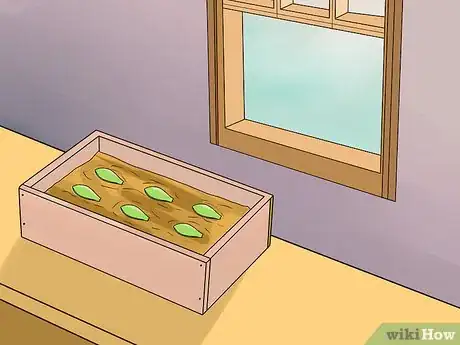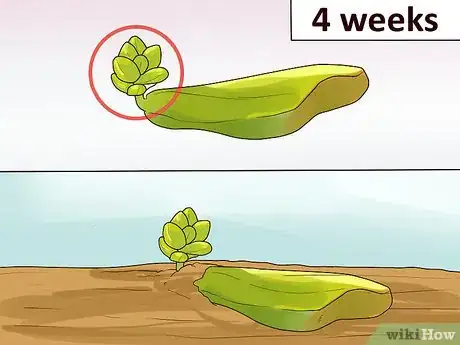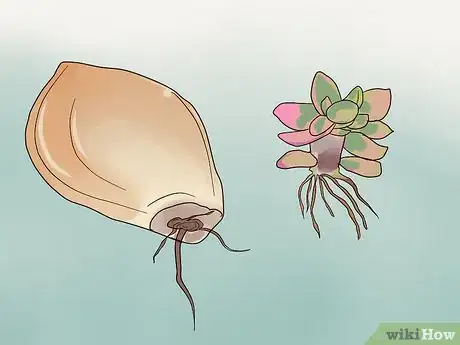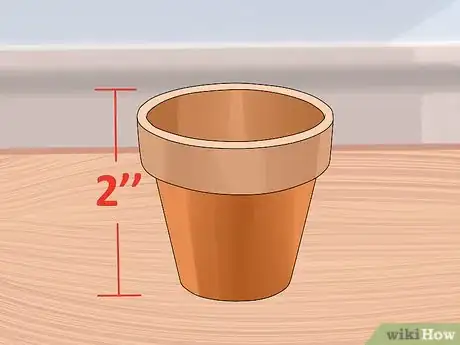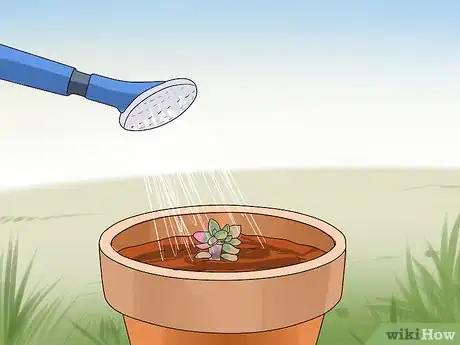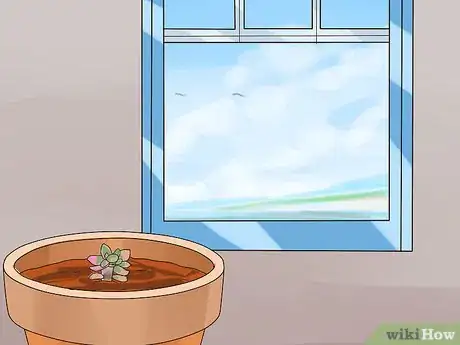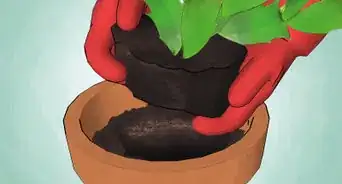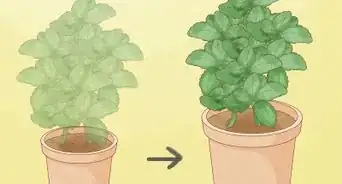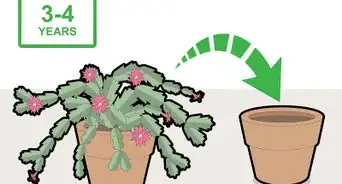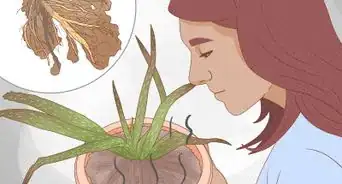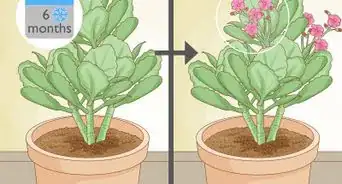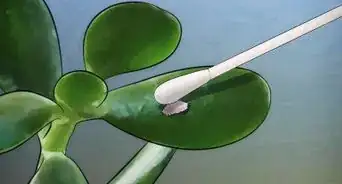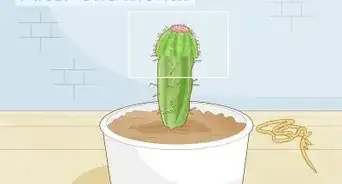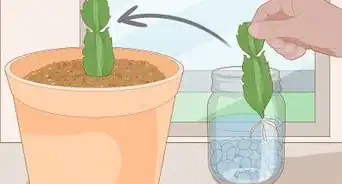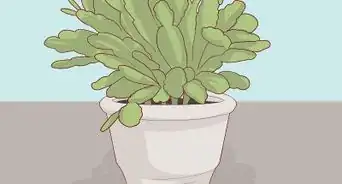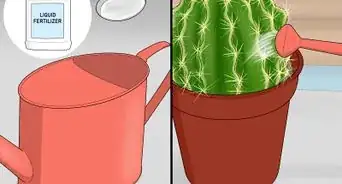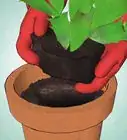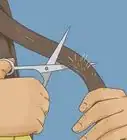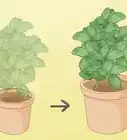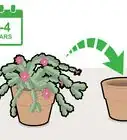This article was co-authored by Katie Gohmann. Katherine Gohmann is a Professional Gardener in Texas. She has been a home gardener and professional gardener since 2008.
There are 8 references cited in this article, which can be found at the bottom of the page.
wikiHow marks an article as reader-approved once it receives enough positive feedback. This article received 71 testimonials and 87% of readers who voted found it helpful, earning it our reader-approved status.
This article has been viewed 1,374,672 times.
Propagating succulents from leaves is a simple project that requires a few steps and a couple supplies. After cutting off a healthy leaf, the leaf will naturally sprout new roots, and a new plant will grow from these roots. Succulents make an excellent gift, are a great way to welcome somebody new to the neighborhood, and can be exchanged between friends and fellow gardeners. It is easy to propagate new succulents from leaves, but because not every leaf will take, you should try rooting at least two leaves at a time.
Steps
Removing and Drying the Leaves
-
1Pick the right time. The best time to propagate a succulent is when the plant develops a long, woody stem at the bottom. This often occurs because the plant isn't getting enough light, so it grows taller and the leaves begin to space out to reach more light.[1]
- A succulent with a long stem is called a leggy plant.
- Take leaves from the bottom of the plant, and leave the younger and smaller growth near the top.
-
2Choose healthy leaves. Your propagation attempt will have a better chance of succeeding if you start with healthy mother leaves. To find healthy leaves to propagate, look for succulent leaves that:[2]
- Are uniformly colored with no discoloration
- Aren't ripped or torn
- Don’t have any spots or marks
- Are full and plump looking
Advertisement -
3Twist the leaves off the stem. The best way to remove a leaf for propagation is to gently remove it with your fingers. Grab a healthy leaf with your thumb and forefinger. Hold the leaf firmly but gently near the base, where it attaches to the stem. Twist it back and forth slightly, and delicately wiggle it back and forth until it comes off.[3]
- Hold the leaf by the base to prevent breakage. The entire base of the leaf must come off the stem, otherwise it will die.
-
4Let the leaf wounds dry. After you remove the leaves from the stem, lay them out on a towel or parchment-lined baking sheet. Place them somewhere warm in indirect sunlight to dry. Leave them for three to seven days, until the wound heals and a callous or scab forms where the leaf was removed from the stem.
- If you place the cut leaves in soil before the wounds heal, they will rot and die before they grow into new plants.[4]
Sprouting New Roots
-
1Dip the calloused leaves in rooting hormone. Fill a bottle cap with some rooting hormone (Honey works as a great substitute for rooting hormone). Wipe the calloused end of the leaf with a damp towel to moisten it slightly. Dip the moistened end into the rooting hormone. Make a small hole in the potting soil, and immediately place the end of the leaf into this hole. Use your finger to pack the soil around the rooting hormone.
- Rooting hormone is not necessary to propagate succulents from leaves, but it will decrease rooting time and increase the chances of success.[5]
-
2Lay the leaves on a bed of soil. Prepare a shallow tray by filling it with cactus or succulent soil or damp sand. Lay the leaves on top of the soil with the calloused end facing upward and away from the soil.
- It’s important to use cactus or succulent soil, because these plants need well-draining soil to thrive.
- You can also make your own soil mixture by combining equal parts sand, perlite, and potting soil.[6]
-
3Provide the leaves with lots of indirect sunlight. Most succulents are desert-dwelling plants, which means adults need plenty of full sun to thrive. But when you're propagating succulents from leaves, they need indirect sunlight until the new plant is established.[7]
- Keep the leaf cuttings by a warm window that doesn’t get direct sunlight, or that’s protected by a tree or window shade.
-
4Mist daily until new roots grow. Rooting succulents need a bit more water than adults, but too much water will cause them to rot and die. Instead of watering, use a spray bottle to mist the soil every day. You just want the top of the soil damp.[8]
- If you live somewhere with lots of humidity in the air, you may not need to mist the leaves at all while they're rooting.
-
5Cover the roots with soil. After about four weeks, the leaves will start to grow little pink roots from the cut. Sprinkle a thin layer of the soil over the roots to prevent them from drying out.[9]
- Once the roots have been buried, they will continue to grow into a new succulent plant. When the new plant starts to create its own leaves, you can transplant it to its own pot.
Transplanting and Growing the New Succulents
-
1Remove the mother leaf. Eventually, the roots of each new plant will establish and the new succulent will start to form leaves of its own. The mother leaf that you used to propagate the new plant will wither. Gently twist and wiggle the mother away from the new plant. Be careful not to damage the young roots.
- When the mother does wither away, it’s time to transplant each succulent into its own pot.[10]
-
2Prepare small pots with good drainage. Start with 2-inch (5-cm) pots with drainage holes in the bottom. Succulents do better in smaller pots than larger ones. Place a layer of pebbles in the bottom to allow for better drainage. Fill the pot the rest of the way with store-bought or homemade succulent mix.
- The ideal medium for succulents is an equal mixture of sand, perlite, and potting soil.
- You'll need one pot for every new succulent plant you’ve propagated.
-
3Transplant the new succulents. Make a hole in the center of the soil with your finger. Place a new plant into the hole and brush the soil over the roots to cover them.
- It will take about a year before the new succulents reach a normal size. As they grow, you can transplant them into larger pots.[11]
-
4Water when the soil dries out. Once the new plants are established and transplanted, stop the daily misting and switch to an adult succulent watering schedule. Let the soil dry out completely between watering, and only water when necessary.
- When you water a succulent, give it a full soaking so the soil is thoroughly wet.[12]
-
5Provide the plants with lots of sun. After transplanting the new succulents, you can move them to a warm location that gets plenty of direct sunlight. South- and east-facing windows will get the most direct sunlight, as long as there are no obstructions.[13]
Expert Q&A
-
QuestionI'm worried I will damage the roots by transporting the propagated leaf to a new pot. If the roots have established themselves in the soil, should I leave them in the current spot or can I move them?
 Katie GohmannKatherine Gohmann is a Professional Gardener in Texas. She has been a home gardener and professional gardener since 2008.
Katie GohmannKatherine Gohmann is a Professional Gardener in Texas. She has been a home gardener and professional gardener since 2008.
Professional Gardener If the roots are established in the soil, you have two options. You can gently shake the propagated leaf loose, taking care to keep the roots intact, or you can dig up a bit of the soil that the roots are in.
If the roots are established in the soil, you have two options. You can gently shake the propagated leaf loose, taking care to keep the roots intact, or you can dig up a bit of the soil that the roots are in. -
QuestionCan I use a diffuser to mist my cactus?
 Katie GohmannKatherine Gohmann is a Professional Gardener in Texas. She has been a home gardener and professional gardener since 2008.
Katie GohmannKatherine Gohmann is a Professional Gardener in Texas. She has been a home gardener and professional gardener since 2008.
Professional Gardener You shouldn't. Cacti don't need (or want) to be misted- they don't really like humidity. When you water your cactus, water the soil thoroughly. If you mist the soil, your plant will grow shallow, weak roots.
You shouldn't. Cacti don't need (or want) to be misted- they don't really like humidity. When you water your cactus, water the soil thoroughly. If you mist the soil, your plant will grow shallow, weak roots. -
QuestionCan adult succulents be taken out of pots and planted directly in the ground?
 Katie GohmannKatherine Gohmann is a Professional Gardener in Texas. She has been a home gardener and professional gardener since 2008.
Katie GohmannKatherine Gohmann is a Professional Gardener in Texas. She has been a home gardener and professional gardener since 2008.
Professional Gardener Depends on the succulent and on your climate. It is possible in many places. Do some research to find out which succulents are hardy in your area, and make sure you plant them in an area where they will receive the correct amounts of light and water.
Depends on the succulent and on your climate. It is possible in many places. Do some research to find out which succulents are hardy in your area, and make sure you plant them in an area where they will receive the correct amounts of light and water.
Things You'll Need
- Healthy succulent plant
- Parchment-lined baking sheet
- Rooting hormone (honey works too)
- Small bowl
- Shallow tray
- Cactus or succulent soil
- Spray bottle
- Small pots with good drainage
- Pebbles
References
- ↑ http://www.homelife.com.au/gardening/how-to-grow/how-to-propagate-succulents
- ↑ http://gardentherapy.ca/guide-to-growing-succulents/
- ↑ http://needlesandleaves.net/blog/2013/5/31/propagating-leggy-succulents
- ↑ http://www.homelife.com.au/gardening/how-to-grow/how-to-propagate-succulents
- ↑ http://getbusygardening.com/how-to-propagate-succulents/
- ↑ http://getbusygardening.com/how-to-propagate-succulents/
- ↑ http://needlesandleaves.net/blog/2013/5/31/propagating-leggy-succulents
- ↑ http://getbusygardening.com/how-to-propagate-succulents/
- ↑ http://www.succulentsandsunshine.com/propagating-succulents/how-to-propagate-succulents-from-leaves/
About This Article
To propagate succulents from leaves, gently pick 4-6 healthy, plump leaves off of a plant with a long stem. Lay the leaves on a towel in indirect sunlight to dry for 3-7 days. When they’ve dried, dampen the leaf and dip the bottom in a rooting hormone or honey. Then, coat the bottom of the leaf in some soil. Lay all of the leaves on top of cactus soil or damp sand in indirect sunlight, with the ends of the leaves out of the soil, and mist daily until new roots grow. As the new roots sprout, bury them under a thin layer of soil until you have a new succulent! If you want to learn how to transplant your new succulents from our Horticulturist co-author, keep reading!


